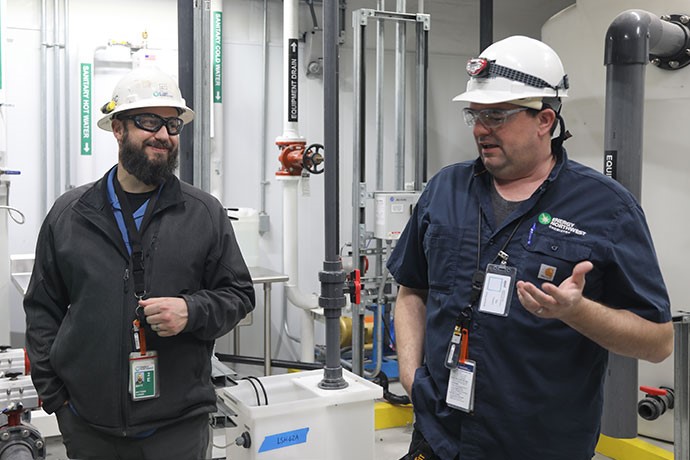EN is in the midst of a 20-plus year effort to restore the land near the IDC to its natural state. A detailed design study began in fiscal year 2019, and the two-phase construction began shortly after.
Phase 1 involved running new electrical lines from an IDC substation down to the Columbia River pumphouse. After getting power to the structure, the EN team installed new pumps and two miles of pipeline to bring water up to the IDC water storage tank.
In Phase 2, a new building was constructed to hold two PALL water filtration systems. A vendor conducted initial system testing in January 2022. When it is fully commissioned, the facility will provide up to 240 gallons per minute of potable water.
Bringing in the experts
While Energy Northwest's Facilities crew was designing and building the surface water treatment plant, Matt Turner, Environmental Services manager, was preparing his team to run the facility.
“I’ve had a passion for this project ever since I first heard about it,” Turner said. “When I saw the opportunity that the Environmental Services team could run it, I just jumped on that.”
To operate the plant, Turner earned three different licenses from Washington state — a water treatment plant operator II, water distribution manager level 2 and a cross-connection control specialist license. Before joining EN about a decade ago, Turner worked at a water treatment plant in Texas.
“I’ve always had a passion for water production, and chemistry in general,” Turner said. “Water is kind of a unique molecule. You’ve got two hydrogen and an oxygen that make up a lot of what’s living, and these bonds are held at a certain angle for a reason. And I get to take it, clean it and make it drinkable.”
Joining Turner in operating the plant is Tim Fitzpatric, water treatment operator and environmental scientist. Before joining EN four years ago, Fitzpatric worked at Indian Point Energy Center in New York for 17 years, including 14 years operating their demineralized water production plant. Following Turner’s lead, Fitzpatric, has also earned two of the three required Washington state licenses.
“I’ve been working with water in nuclear power my entire career,” Fitzpatric said. “It’s always exciting to have a hand in opening a new treatment facility, with an opportunity to apply innovative technologies.”
Turner and Fitzpatrick aren’t the only ones on the project who joined with a particular expertise. Before joining EN’s Environmental & Regulatory Programs (E&RP) team as an environmental scientist in March 2021, Denis Mehinagic worked for the Washington State Department of Health (WADOH) as an engineer, overseeing the design and approval process for water systems.
Mehinagic helped EN through the WADOH submittal process and provided technical reviews before the team submitted the engineering documents. The E&RP team oversees all EN’s potable water compliance and interfaces with regulatory agencies.
Future growth
Columbia Generating Station receives potable water from the flocculator, which was built in 1975 to clean surface water. When the flocculator is down, repair is expensive.
“We built the new water treatment plant with the idea that we could potentially expand it and replace the flocculator,” said Jay Ashbaugh, Facilities & Commercial Engineering manager. The new facility contains two filtration systems, but there is room to add one more. “With some more work on the piping and pumping, regulatory requirements and engineering, we could potentially use this system to feed potable water to Columbia Generating Station. A lot more work will be required, but the base infrastructure will now be in place.”
Replacing the flocculator with water from the new system will require additional regulatory approvals and potentially the transferring of water rights, and there’s no established timeline for making the transition. However, Ashbaugh said the work done to get the surface water treatment facility running will make it easier to grow in the future, whether that’s to move water to Columbia Generating Station, be a reliable backup to the flocculator or to support any new nuclear developments at the IDC.
